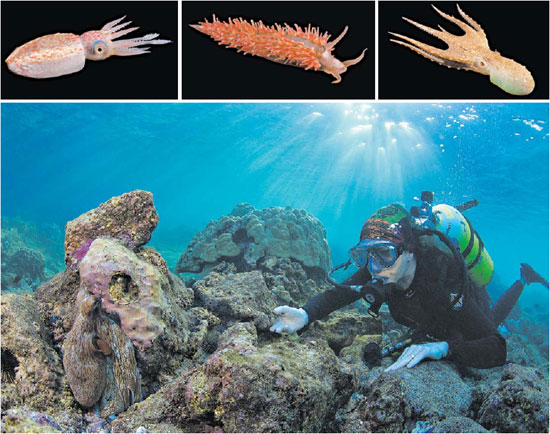In pursuit of underwater menagerie
Updated: 2013-05-19 07:34
(The New York Times)
|
|||||||
|
Inspired by glass sculptures, C. Drew Harvell, above, and a filmmaker, David O. Brown, are tracking changes in marine life. Top, some of the sculptures of invertebrates created by Leopold and Rudolf Blaschka: from left, a comb-finned squid, a sea slug and an Atlantic warty octopus. Photographs by Kent Loeffler, top; David O. Brown |
MAUNA LANI REEF, Hawaii - After a long, cold swim in the dark, we spotted it on the night reef with our dive lights: Octopus ornatus, the ornate octopus, a 30-centimeter-long creature in an amber shade of orange with bright white spots and dashes along its arms.
It sat stolidly in the light of the camera, nine meters below the surface, unfazed. I reached out a finger and it touched me with its suctioned tentacles. When it scuttled in the other direction, I herded it between my cupped hands as it watched me attentively with searching golden eyes.
As if levitating, it smoothly lifted off and tried to jet over my head, but slowly enough that I could catch it gently. I looked into its eyes. Then a tentacle slapped my mask. The octopus crawled up my arm and vanished into the night.
I've been a marine biologist my entire professional life, spending more than 25 years researching the health of corals and sustainability of reefs. I'm captivated by the magic of sessile invertebrates like corals, sponges and sea squirts - creatures vital to the ecosystem yet too often overlooked in favor of more visible animals like sharks and whales.
The filmmaker David O. Brown and I want to change that. To make a documentary, "Fragile Legacy," we are on a quest to lure these elusive and delicate invertebrates in front of the camera lens.

Our inspiration springs from a collection of 570 superbly wrought, anatomically perfect glass sculptures of marine creatures from the 19th century.
These delicate folds and strands of glass make up the Blaschka collection of glass invertebrates at Cornell University in Ithaca, New York, of which I am the curator - enchanting and impossibly rare jellyfishes of the open ocean; more common but equally beautiful octopus, squid, anemones and nudibranchs from British tide pools and Mediterranean shores.
They are the work of an extraordinary father-and-son team, Leopold and Rudolf Blaschka. Leopold Blaschka (1822-95) was a Czech immigrant to Dresden, in what is now Germany; on a trip to America in 1853, his ship was becalmed and he was enchanted by a spectacular display of bioluminescence from a type of jellyfish called a siphonophore. He decided to study the jellyfish more closely and create their likenesses in glass.
David Brown and I came to Hawaii with the goal of making videos of as many Blaschka cephalopod look-alikes as we could find.
The oceans are changing rapidly, with a 30 percent increase in acidity in the last 200 years, lethally stressful warming in many tropical seas, and significant coastal pollution and overfishing just about everywhere. If ever there was a time to compare the plentiful past with an ocean in jeopardy, that time would be now.
The chances of finding cephalopods are much improved while they are out foraging at night. So we did a series of night reef dives, followed by a "black water" dive five kilometers off the Kona coast.
That one put us in water 300 meters deep, with the possibility of encountering tiger sharks and great white sharks. The captain turned off the lights, the better to see bioluminescent "black magic."
We clipped onto our safety lines and slipped into darkness punctuated by bioluminescent splashes. We had to drift close to identify whether these splashes were from jellyfish, ctenophores, salps or squid. The sparkles of bioluminescence turned into a stream of tiny plankton.
What I really hoped to see were siphonophores, the creatures that so inspired Leopold Blaschka in 1853 and whose models are some of the most intricate in our collection.

The glass model of Apolemia uvaria has the basic form of a siphonophore that I could see before me - the large swimming bell, its powerhouse for fast movement, and the long dangling tentacles - each capped with a harpoon loaded with neurotoxin - that are death traps for all manner of small shrimp and fish.
And the siphonophores put on quite a show for us, even if they were wickedly hard to film.
When they encountered danger, their nervous systems fired a signal to muscles that zipped up the tentacles and powered the swimming bell to high speed. A meter-long string of stinging tentacles contracted in a flash to an eight-centimeter stream of jet propulsion.
The next stop in our quest is the Mediterranean. I will head to Italy, to the Naples Marine Station, which supplied the glassmakers with many of their live animals.
Perhaps we'll find exact matches for such spectacular invertebrates as the curly tentacled octopus (Eledone moschata) and the giant siphonophore Apolemia uvaria, which at six meters long can dominate a Mediterranean food web. At any rate, we hope to find out whether they are surviving in the sea as magnificently as they do in glass.
The New York Times
(China Daily 05/19/2013 page11)
